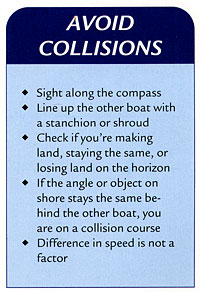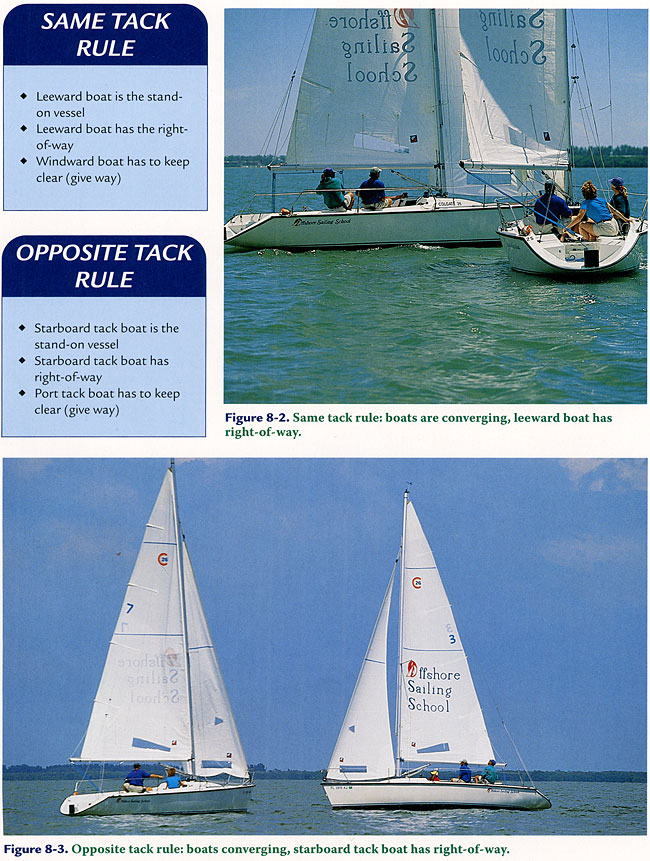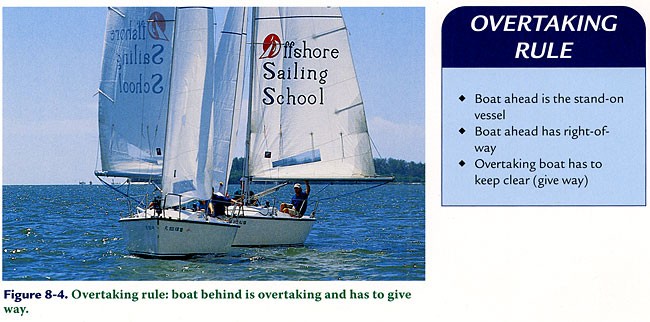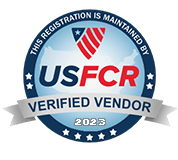Sailing Rules of the Road
When Sailboat Meets Sailboat
There are only three basic possibilities, and three basic boating rules of the road to follow, when your sailboat approaches another sailboat.
Rule 1: When you are on the same tack as the other boat, the leeward boat has the right-of-way.
Rule 2: When you are on opposite tacks, the starboard tack boat has the right-of-way.
Rule 3: If you are overtaking the other boat, or it is overtaking you, the boat ahead (the overtaken boat) has the right-of-way.
In Figure 8-2, two boats are approaching each other and subject to the same tack rule. Sailors refer to the boat with right-of-way as the stand-on vessel-the boat that must hold its course. The leeward boat has right-of-way, and the windward boat has to keep clear, or give way. Which boat is the leeward boat? If you said the boat on the left, you were correct.
Figure 8-3 shows the opposite tack rule. The starboard tack boat is the stand-on vessel and has the boating right-of-way. The port tack boat has to keep clear or give way. Which boat is on port tack? If you said the boat on the right, you are correct.
Figure 8-4 shows two boats involved in the overtaking rule. In this case the boat ahead is the stand-on vessel and has the boating right-of-way. The overtaking boat has to keep clear or give way. Which boat is overtaking and what tack is that boat on? If you said the boat behind is overtaking and is on starboard tack, you are correct.
Note that these boats are sailing downwind, with the wind pushing from behind, and they are on opposite tacks. In the overtaking rule, the difference in tacks is not relevant, unless you are racing. Over many years, a complete set of sailing rules of the road specifically for sailboat racing has been developed and administered by the International Sailing Federation (ISAF), but these are not relevant to recreational sailing. If you’re looking to become a pro sailor, check out our Offshore Sailing Certification Courses.
Key Takeaways:
- Right of Way Rules are Essential: Understanding sailing right of way rules, like port/starboard tack and windward/leeward, is crucial for safe navigation and collision avoidance.
- Proactive Safety Measures are Key: Maintaining a vigilant lookout, communicating intentions, and adjusting speed based on conditions help prevent potential collisions.
- Powerboat vs. Sailboat Distinctions Exist: While sailboats under sail generally have right of way, exceptions exist in narrow channels, overtaking situations, and when using a motor.
- Visibility Impacts Navigation: In restricted visibility, reducing speed, using navigation lights and sound signals, and staying aware of surroundings are vital for safety.
- Continuous Learning Enhances Safety: Sailing education, including understanding local regulations and practicing good seamanship, is essential for a safer sailing experience.
Sailing is an exhilarating experience that becomes even more enjoyable when safety remains the top priority. Understanding and applying sailing right of way rules is essential to ensuring a smooth and secure journey on the water.
Knowing sailing rules of the road ensures that vessels can navigate the waters smoothly without accidents. Failing to follow these regulations can lead to dangerous collisions, legal issues, or even serious injuries.
In this comprehensive guide, we’ll cover everything you need to know about sailboat right of way rules, how to apply right of way sailing principles, and essential techniques to avoid collisions. By mastering these rules, you’ll not only enhance your confidence on the water but also contribute to a safer sailing environment for everyone.
The Sailing Right of Way
The sailing right of way is a set of guidelines that dictate which vessel must yield in different sailing scenarios. These rules help sailors navigate without confusion, reducing the risk of close encounters and potential collisions.
Key Right of Way Rules Every Sailor Must Know
To safely share the water with other vessels, it’s essential to understand the hierarchy of sailing right of way rules:
- Port Tack vs. Starboard Tack: A boat on a port tack (wind coming from the port side) must give way to a boat on a starboard tack (wind coming from the starboard side). The starboard tack vessel has the sailboat right of way in this situation.
- Windward vs. Leeward Vessel: When two boats are on the same tack, the windward vessel (the boat closest to where the wind is coming from) must yield to the leeward vessel. The leeward vessel has right of way sailing and should maintain its course.
- Overtaking Rule: Any vessel overtaking another must keep clear, regardless of whether it is a sailboat or a powerboat. The overtaking boat is always the give-way vessel.
- Powerboat vs. Sailboat: A sailboat under sail power has the sailboat right of way over a powerboat. However, if the sailboat is using its engine (even with sails up), it is considered a power-driven vessel and must follow standard rules of the road for motorized boats.
Following these fundamental rules prevents miscommunication and ensures smooth navigation among all vessels on the water.
Practical Tips to Prevent Collisions While Sailing
Beyond knowing right of way sailing rules, every sailor should practice proactive safety measures. Applying these best practices will help you anticipate and avoid potential dangers.
Best Practices for Collision Avoidance
- Maintain a Proper Lookout: Always scan the horizon for other vessels, obstacles, and changing weather conditions. A vigilant lookout can prevent sudden encounters.
- Communicate Intentions Clearly: Use hand signals, sound signals (horn or whistle), or VHF radio to indicate your intended course, especially in tight passages or crowded waters.
- Adjust Speed Based on Conditions: Reduce speed in busy areas, poor visibility, or unpredictable wind conditions. Slow speeds allow for better maneuverability.
- Change Course to Indicate Your Intentions: This makes it obvious what your plan is to avoid a collision.
- Stay Updated on Local Regulations: Certain sailing areas have specific rules of the road or unique right-of-way conditions that must be followed. Check local guidelines before heading out.
By implementing these sailing right of way practices, sailors can reduce risks and enjoy safer, more controlled navigation.
Navigate in Offshore and International Waters
Sailing in offshore waters and international waters comes with additional considerations due to larger vessel traffic and changing weather conditions. The sailing right of way rules remain the same, but sailors must be extra cautious in these environments.
Best Practices for Offshore and International Waters
- Give Large Vessels Ample Space: Stay outside the outer limit of a large ship’s maneuvering area to avoid sudden course changes.
- Use AIS and Radar (if applicable): Electronic navigation aids help monitor traffic, especially in restricted visibility conditions.
- Stay Updated on Local Navigation Rules: Different countries may have relevant rules that slightly modify international guidelines.
Practicing these techniques ensures that sailors can confidently handle complex situations and navigate safely in heavily trafficked bodies of water.
Start Your Sailing Education with Offshore Sailing School
If you want to master sailing right of way, improve your boat handling skills, and gain real-world experience with expert instructors, Offshore Sailing School is the perfect place to start. We offer comprehensive sailing courses in Florida and the British Virgin Islands.
Enroll today and learn the skills needed to sail safely and confidently in offshore, coastal, and international waters!
Frequently Asked Questions
What is the most important rule to follow to avoid a collision while sailing?
The most critical rule in preventing a collision between vessels is maintaining a proper lookout and operating at a safe speed. Every sailing vessel and powered vessel must follow navigation rules that dictate right of way sailing situations. Responsibilities of vessel operators include understanding when to yield, when to stand on, and when to take substantial action if the risk of collision exists. Using common sense and good seamanship is essential for avoiding accidents.
How should a sailor react in restricted visibility to prevent a dangerous situation?
In restricted visibility, such as fog, heavy rain, or night sailing, all vessels must proceed with extra caution. To prevent a dangerous situation, sailors should:
- Reduce to a safe speed to allow for reaction time.
- Use navigation lights and sound signals to alert nearby vessels.
- Listen for foghorns or radio communication to determine nearby traffic.
- Stay aware of larger power vessels in offshore waters or international waters that may have limited maneuverability.
Taking effective action early and staying within the outer limit of the sailing lane ensures safe navigation in poor visibility conditions.
When does a sailing vessel have to give way to a powered vessel?
A sailing vessel typically has right of way sailing over power vessels, but there are exceptions where it must yield:
- When in a narrow channel or shipping lane.
- When overtaking another vessel (the overtaking vessel must always give way).
- When the sailing vessel is using its motor and is considered a powered vessel.
- When the risk of collision exists with a larger vessel that has limited ability to maneuver, such as in bodies of water with heavy commercial traffic.
- Stay clear of a fishing vessel trawling.
Understanding these relevant rules and knowing when to take substantial action helps prevent confusion and ensures safe navigation.











